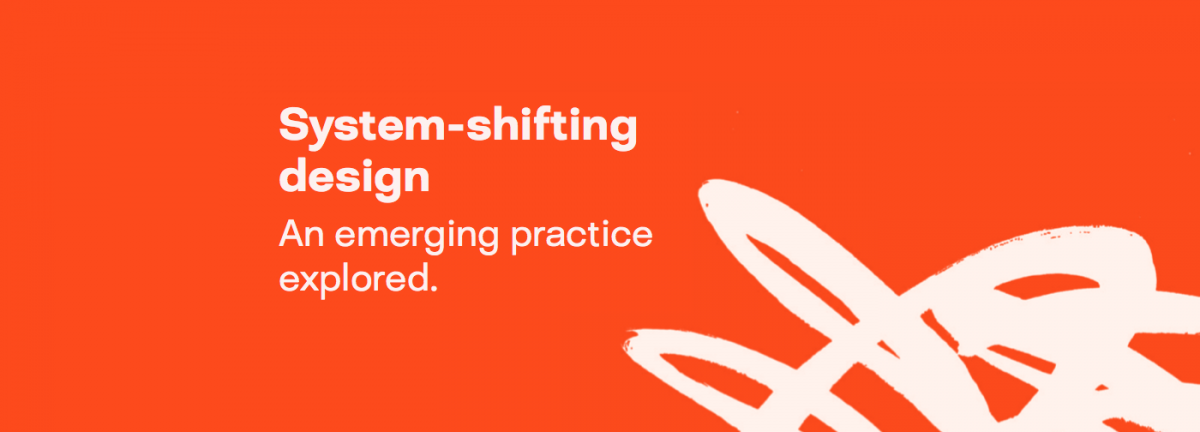New report challenges designers to experiment with new approaches in systemic design

Current design system must get ready to shift to achieve a more equal and sustainable world.
Design practice – and the system that governs it – must evolve if we are to transition to a more regenerative and just world, according to a report launched today by Design Council and The Point People. System-Shifting Design: An Evolving Practice Explored synthesises insights from an 18-month enquiry with 38 designers working at the cutting edge of their practice. It explores what ‘next practice’ around systemic design looks like, and how the design system itself might need to change to allow more designers to do things differently.
System-Shifting Design welcomes the increase in designing for system change, and in particular the impact of the pandemic in highlighting the interconnections that shape our world. However, it argues that while designers are adept at working in complex systems, it is not clear that they have the right ways to address deep rooted issues and shift to more hopeful futures.
Starting with a critique of the current system of design, the report argues that some of the characteristics that helped it become so popular in recent years – such as being user-centred, prototyping to reduce risk, and focusing on solving a single problem – are not appropriate when working in complex systems. It suggests that instead designers need to be planet-centred, be bold and take risks, and see their design as one of many that must work together as an ecosystem of innovation to shift to a sustainable future.
System-Shifting Design – which is written for the 1.69m people working in the design economy as well as commissioners – pushes designers and those in the design system to do things differently to achieve more sustainable and equal systems. It recognises that designers – working deep in non-design organisations, or in SMEs or as freelancers – are often constrained by procurement, commissioning and governance systems. The report provides some provocations for how conventional Western design practices and the economic models that underpin them need to shift. For example, it brings into view some indigenous and natural ways of knowing that designers can learn from.
The findings from the enquiry – made up of group discussions and one-to-one interviews – are particularly timely. Many designers across the world are considering their position around the climate crisis with the galvanising movements around COP26 and the new European Bauhaus, a pan-European creative and multidisciplinary initiative to design sustainable and beautiful future ways of living.
Cat Drew, Chief Design Officer at Design Council said: “Designers have remarkable skills, which can help the world transform. They use their creativity to imagine something different, and their making skills to bring this to life, inspire others and show what is possible. Designers also see how the world is connected and fuse further links. But to shift systems intentionally, designers need to work in new ways, and the design system must change to allow them to do so. System-Shifting Design takes a look at what emerging practice might be. It is acts as an invitation to designers to design differently and as a prompt to those within the design system to find alternative approaches to govern, commission, educate and assess value.
Our contributors have uncovered many new paths and appreciate that there is still so much more to know. This means considering the indigenous and natural ways of knowing that designers can learn from. It is vital to us that our work stays open to alternative or previously marginalised ways of seeing and understanding. We look forward to sharing it and hearing others’ views.
US professor, researcher and author, Don Norman, Founder and first Director of The Design Lab at University of California, San Diego, said: "System-Shifting Design is what the world needs right now. Because the world is falling apart and something has to change. I argue in my upcoming book, ‘Four Maxims to Save the World’ that almost everything I see is artificial, designed by people over thousands of years. If people designed it, maybe design can save it, but to do this, everything has to change. Many people are simply repeating the history of oppression. They remind us of all the injustices in the world, the collapse of the environment and civilization, but they don't bring any actionable suggestions about what we need to do. I am always searching for what we can do. The entire focus of this report is on what we can do. It should be applauded. It should also be critiqued and built upon, as its authors suggest.”
-
The publication is co-authored by: Cat Drew, Chief Design Officer; Cassie Robinson, co-founder of The Point People, and Jennie Winhall, founder of system innovation group ALT/Now and member of The Point People.It features the following designers in conversation: Araceli Camargo, Annabelle Campbel, Andrea Cooper, Sarah Drummond, Palak Dudani, Dr Gyorgyi Galik, Sarah Gold, Adam Groves, Indy Johar, Dr Makalya Lewis, Sarah Mann, Dr Jo Morrison, Julia Shaeper, Deborah Szebeko, Seetal Solanki, Nick Stanhope, Tero Väänänen, Alastair Parvin, Josina Vink, Laura Melissa Williams. It also includes the following designers in one-to-one interviews: Ahmed Ansari, Kenneth Bailey, Dr Emma Blomkamp,Tessy Britton, Dr Marie Davidová, Professor Kees Dorst, Wayne Hemingway, Dan Hill, Anab Jain, Professor Lucy Kimbell, Lori Lobenstine, Dan Lockton, Bruce Mau, Dr Christian Nold, Gaetan du Peloux, Dr Daniela Sangiorgi, Akil Scafe-Smith, Dr Daniel Christian Wahl.
Category: Design Education & Skills
Subscribe to our newsletter
Want to keep up with the latest from the Design Council?
